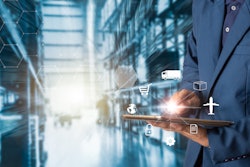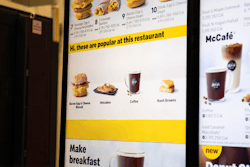
Supply chains are becoming increasingly globalized and more complex. Raw materials and products travel across many geographical locations and pass through multiple suppliers, manufacturers, distributors, carriers and service providers. Often, the supply chain is unaware of how many trading partners are really involved. In theory, organizations should know all parties in their supply chain network (within the broader business ecosystem) and trust them, but this is far from today’s reality. Blockchain technologies, for example, could be an answer to address this problem across three areas — counterfeiting, visibility/traceability and efficiency play.
Although supply chain-related blockchain initiatives are nascent, with solutions in early stages of development, interest has accelerated significantly during the past year, making blockchain a top trend for supply chain leaders to watch in 2019.
“As companies seek to exploit the benefits of greater levels of digitization, new and innovative technologies, such as blockchain and artificial intelligence (AI)/machine learning, can potentially and significantly disrupt existing supply chain operating models,” says Christian Titze, vice president analyst, Gartner.
Gartner identified the Top 8 strategic supply chain technology trends that have broad industry impact, but haven’t yet been widely adopted. These technologies are experiencing significant changes or reaching critical tipping points in capability or maturity.
Artificial intelligence
AI supports an organization’s vision for broader supply chain automation. The level of automation could be semiautomated, fully automated or a mix, depending on the circumstances. Through self-learning and natural language, AI solutions can help automate various supply chain processes such as demand forecasting, production planning or predictive maintenance. Along with automation comes augmented human decision making, because the human is then no longer involved in the decision making.
“AI in supply chain consists of technologies that seek to emulate human performance and knowledge, such as Improving order delivery and service levels by using AI capabilities to determine the routes a company should take to optimize deliveries, or optimizing shipping replacement parts by applying AI algorithms and notifying users of a potential equipment failure prior to it occurring,” says Titze.
Advanced analytics
The impact of advanced analytics on supply chain is significant. Advanced analytics are increasingly being deployed in real time or near-real time in areas such as dynamic pricing, product quality testing and dynamic replenishment. The availability of supply chain data — such as Internet of Things (IoT) data, dynamic sales data and weather patterns — provides the ability to extrapolate the current environment to better understand future scenarios and make profitable recommendations.
Internet of Things
IoT adoption is growing in select supply chain domains, but rarely as part of a complete end-to-end supply chain process. Some manufacturers are assessing the business value of expanding beyond their current use of operational technology— digitized devices often having closed or proprietary connectivity. Logistics groups already use sensors to track assets or containers. The IoT could have a broad and profound impact on the supply chain in areas such as improved asset utilization and higher uptime, improved customer service, improved end-to-end supply chain performance, or improved supply availability, supply chain visibility and reliability.
Robotic process automation
Robotic process automation (RPA) tools cut costs, eliminate keying errors, speed up processes and link applications. RPA has proven to be very effective in simple use cases, mainly where a third party in the supply chain will not provide an API or other means for automated data integration. However, the potential to achieve strong return on investment is entirely dependent on the applicability of RPA in each individual organization.
Autonomous things
The rapid explosion in the number of connected, intelligent things has given this trend a huge boost. Robots, drones or autonomous vehicles enable new business scenarios and optimize existing ones. Autonomous things are often physical devices operating in the real world, such as robots carrying out jobs in a coordinated fashion to create a seamless and connected process in manufacturing facilities or by using drones for inventory quality assurance through taking images with the drone’s camera to reduce time for inventory checks.
“Supply chain leaders should evaluate the use of autonomous things as both substitutes and complements to the human human workforce. Labor reductions seem the most likely drivers, but improvements in overall output and productivity will be the primary value, regardless of whether labor is reduced,” says Titze.
Digital supply chain twin
A digital twin is a digital representation of a real-world entity or system. A digital supply chain twin is a digital representation of the relationships between all the relevant entities of an end-to-end supply chain — such as products, customers, markets, distribution centers/warehouses, plants, finance, attributes and weather. It creates end-to-end visibility by being in sync with the real-world supply chain. This link greatly enhances situational awareness and increases the quality and speed of decisions.
“Organizations would use a digital supply chain twin for all levels of supply chain decision making, from strategic through to executional. Appropriate predictive and prescriptive analytics (including machine learning and AI) would be applied to the digital supply chain twin so that aligned (and to some degree, automatic) decisions could be made,” says Titze.
Immersive experience
The user experience will undergo a significant shift in how users perceive the digital world and interact with it. The integration of virtual reality (VR) and augmented reality (AR) with multiple mobile, wearable, IoT and sensor-rich environments and conversational platforms will extend immersive applications beyond isolated and single-person experiences.
Supply chain leaders can use these platforms to save time, improve safety and make mundane tasks easy, for example, using AR to provide renderings of equipment to visualize the footprint in a defined space to compare different configuration options or using voice-controlled personal assistants to remotely check product features or appointments.
Blockchain
Blockchain is aligned to potentially fulfill critical and long-standing challenges presented across dynamic and complex global supply chains that traditionally have held centralized governance models. Current capabilities offered by blockchain solutions for supply chain include a loose portfolio of technologies and processes that spans middleware, database, verification, security, analytics and contractual and identity management concepts.
Blockchain is also increasingly being offered as a service or development option across supply chain solutions that target closely aligned objectives such as automation, traceability and security. A critical aspect of blockchain technology today is the unregulated, ungoverned verification of successful transactions, as well as immutability. These capabilities currently fund much of blockchain development for supply chain.

















